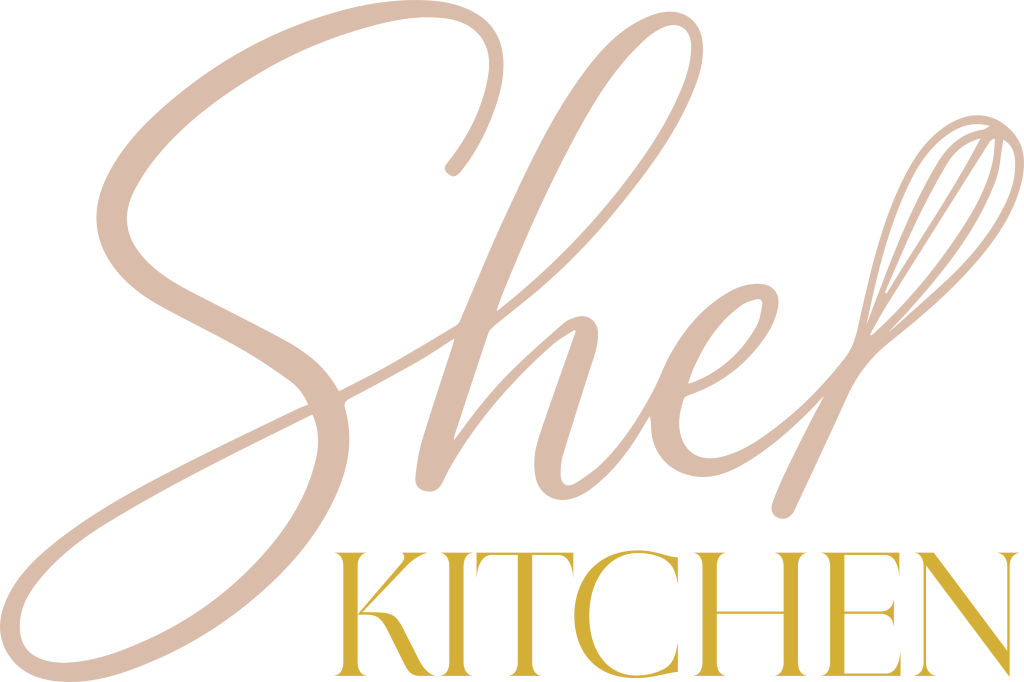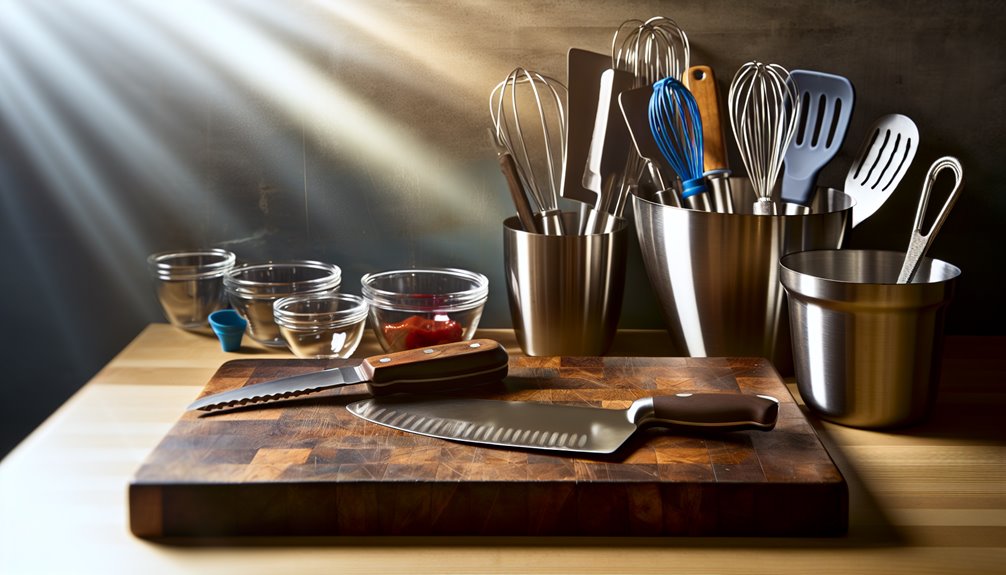In every kitchen, you’ll want a chef’s knife for chopping, a sturdy cutting board, and a versatile paring knife for detailed tasks. Don’t forget mixing bowls for prep, measuring cups for accurate portions, and a saucepan for boiling. A Dutch oven is great for slow-cooked meals, while a food processor saves time on chopping. An immersion blender makes quick work of soups and smoothies. Discover even more essentials that can elevate your cooking game!
Key Takeaways
- A chef’s knife is essential for versatile slicing, chopping, and dicing tasks in any kitchen.
- Mixing bowls and measuring tools are crucial for accurate ingredient preparation and recipe execution.
- A non-stick skillet simplifies cooking and cleanup, making meal preparation less stressful.
- A food processor streamlines meal prep by quickly chopping, slicing, and pureeing ingredients.
- A colander is vital for draining and rinsing ingredients, enhancing the freshness of your meals.
Chef’s Knife
A chef’s knife is the cornerstone of any kitchen, essential for both amateur cooks and culinary professionals alike. It’s your go-to tool for a variety of tasks, from slicing vegetables to chopping herbs.
Understanding different chef’s knife styles can help you choose the right one for your needs. Whether you prefer a German-style blade for its weight and durability or a Japanese-style knife for its precision and sharpness, each has unique benefits.
To guarantee your knife remains effective, mastering knife sharpening techniques is vital. Regular honing keeps the edge aligned, while periodic sharpening restores its sharpness.
Investing time in these practices won’t only enhance your cooking experience but also prolong the life of your chef’s knife, making it an invaluable asset in your kitchen.
Cutting Board
Choosing the right cutting board is essential for any kitchen, as it provides a stable surface for food preparation.
You’ll find cutting boards in various sizes, from small for quick tasks to large ones for big meals. Consider the cutting board materials, too; options like wood, plastic, and bamboo each have their pros and cons.
Wooden boards are durable and gentle on your knives, while plastic ones are lightweight and easy to sanitize. Bamboo offers an eco-friendly alternative.
When selecting, think about your cooking habits and available space. A larger board is great for prepping multiple ingredients, but a smaller one may suit a compact kitchen better.
Make sure to choose wisely to enhance your cooking experience!
Paring Knife
A paring knife is an essential cutting tool in your kitchen arsenal.
Its versatility makes it perfect for tasks like peeling, trimming, and intricate cutting.
To keep your paring knife in top shape, you’ll want to follow some simple maintenance tips.
Essential Cutting Tool
The paring knife stands out as an essential cutting tool in any kitchen. Its small size and sharp blade make it perfect for intricate cutting techniques like peeling, trimming, and slicing.
You’ll find it invaluable for tasks that require precision, such as deveining shrimp or sectioning citrus fruits. To guarantee knife safety, always use a cutting board and keep your fingers tucked away from the blade.
Grip the handle firmly and make deliberate, controlled cuts. Remember, a dull blade can be more dangerous than a sharp one, so keep your paring knife well-maintained.
Investing time in mastering this tool will elevate your culinary skills and enhance your overall cooking experience.
Versatile Kitchen Use
With its nimble blade and comfortable grip, the paring knife proves to be one of the most versatile tools in your kitchen. This multifunctional gadget can tackle a range of tasks, allowing you to save kitchen space by minimizing the number of tools you need.
- Peel fruits and vegetables with ease
- Trim and devein shrimp or other delicate proteins
- Create intricate garnishes for a touch of elegance
Whether you’re slicing an apple or deveining a shrimp, the paring knife’s precision and control make it indispensable.
Its compact size also means you can store it easily, making it a perfect fit for any kitchen.
Embrace the versatility of this essential tool to enhance your culinary experience!
Proper Maintenance Tips
To guarantee your paring knife remains sharp and effective, regular maintenance is key.
Start by handwashing your knife with mild soap and warm water, avoiding the dishwasher to prevent dulling. After washing, dry it thoroughly to prevent rust.
Keep your knife sharp by honing it regularly with a honing steel; this helps maintain its edge.
Store your paring knife in a designated knife block or sheath to guarantee safety and tool organization.
Also, practice kitchen cleanliness by cleaning your workspace after each use, preventing cross-contamination.
With these simple steps, you’ll not only prolong the life of your paring knife but also enhance your overall cooking experience.
Mixing Bowls
Mixing bowls are essential kitchen tools that simplify food preparation and baking tasks.
Whether you’re whipping up a cake batter or tossing a salad, the right mixing bowl can make all the difference.
Consider these features when choosing your mixing bowls:
- Variety of sizes: Having multiple sizes allows for different mixing techniques and recipes.
- Durable bowl materials: Options like glass, stainless steel, or plastic each have unique benefits, from heat resistance to light weight.
- Non-slip bases: A bowl with a non-slip base keeps it steady while you mix.
Investing in high-quality mixing bowls will enhance your cooking experience, making it easier to handle various ingredients and achieve the perfect blend every time.
You’ll wonder how you ever managed without them!
Measuring Cups
Measuring cups are indispensable for achieving precise ingredient ratios in your cooking and baking. Whether you’re whipping up a cake or crafting a savory dish, understanding measuring techniques is vital.
You’ll find measuring cups come in various cup materials, including plastic, glass, and stainless steel, each offering unique advantages. Glass cups let you see your ingredients clearly, while stainless steel provides durability.
When using measuring cups, make certain you’re leveling off dry ingredients for accuracy and checking liquid measurements at eye level. This attention to detail will elevate your culinary creations.
Investing in a set of reliable measuring cups can make all the difference, helping you replicate your favorite recipes with confidence. So, don’t overlook this essential kitchen tool!
Measuring Spoons
When it comes to cooking, accuracy is key, and that’s where measuring spoons come in.
You’ll find various types of measuring spoons designed for different ingredients, ensuring you get the right amount every time.
Let’s explore how these handy tools can elevate your cooking experience.
Importance of Accuracy
Accuracy in cooking is essential, especially when it comes to using measuring spoons. When you measure ingredients correctly, you elevate your dishes and guarantee they turn out as intended.
Precision cooking relies heavily on measurement accuracy, so having the right tools at hand makes a significant difference.
- Consistent flavors: Accurate measurements lead to balanced taste.
- Improved texture: The right amounts create the desired consistency.
- Successful results: Follow recipes closely to achieve your culinary goals.
Using measuring spoons not only saves you time but also boosts your confidence in the kitchen.
You’ll find that precision in your measurements can transform ordinary meals into extraordinary ones. Embrace the importance of accuracy, and watch your cooking skills flourish!
Types of Measuring Spoons
Having the right measuring spoons can make all the difference in your cooking experience. You’ll find various types of measuring spoon sizes, typically ranging from 1/4 teaspoon to 1 tablespoon. Choosing spoons that suit your needs is essential.
Measuring spoons come in different types of materials, including stainless steel, plastic, and ceramic. Stainless steel spoons are durable and easy to clean. Plastic spoons are lightweight and often come in vibrant colors, but they may warp over time. Ceramic spoons offer a stylish touch but can be more fragile.
When selecting measuring spoons, consider how they’ll fit into your cooking routine. Each type of material and size can enhance your accuracy, making your culinary adventures more enjoyable and successful.
Whisk
A whisk is an essential kitchen tool that transforms ingredients with a simple flick of your wrist.
With various whisk types available, you can choose one that fits your needs, whether for beating eggs or mixing batter. Mastering different whisk techniques will elevate your cooking game.
- Balloon Whisk: Perfect for aerating and whipping cream.
- Flat Whisk: Ideal for blending sauces and gravies seamlessly.
- Dough Whisk: Great for mixing thick dough without overworking it.
Using a whisk not only saves time but also guarantees a smooth, consistent texture in your dishes.
Get familiar with your whisk and watch how it makes cooking more enjoyable and efficient!
Wooden Spoon
A wooden spoon is one of the most versatile tools in your kitchen.
It’s gentle on your cookware, so you won’t have to worry about scratches or damage.
Plus, cleaning it’s a breeze, making it a must-have for any home cook.
Versatility in Cooking
While many kitchen tools serve specific purposes, the wooden spoon stands out for its remarkable versatility in cooking. You’ll find it invaluable for various cooking techniques, whether you’re stirring, mixing, or even sautéing.
- Perfect for delicate sauces
- Ideal for incorporating ingredient substitutions
- Great for scraping the bottom of pots
With a wooden spoon, you can easily shift from preparing a hearty stew to whipping up a light batter. Its sturdy yet gentle nature allows you to maneuver through a variety of textures without damaging your cookware.
Plus, it’s easy to clean and maintain, making it a reliable companion in your culinary adventures. Embrace the wooden spoon’s versatility, and elevate your cooking experience!
Gentle on Cookware
Because wooden spoons are gentle on cookware, they’re a must-have in any kitchen. Their smooth surfaces and gentle materials won’t scratch or damage your pots and pans, ensuring cookware safety with every stir.
Unlike metal utensils, wooden spoons glide effortlessly over non-stick surfaces, preserving the integrity of your favorite cookware. They’re perfect for mixing, sautéing, and serving, making them versatile tools for countless recipes.
Plus, wooden spoons don’t conduct heat, so you won’t burn your hands while cooking. When you want to protect your investment in quality cookware, reach for a wooden spoon.
It’s an essential tool that combines functionality with care, making it easy to whip up delicious meals without worrying about damaging your utensils.
Easy to Clean
Cleaning wooden spoons is a breeze, making them a practical choice for any kitchen.
These essential tools not only enhance your cooking experience but also fit seamlessly into your kitchen organization efforts.
With the right cleaning techniques, maintaining their beauty and functionality is simple.
- Hand wash with mild soap: Avoid soaking to prevent warping.
- Dry immediately: This prevents moisture buildup and prolongs their life.
- Oil regularly: Use food-safe mineral oil to keep the wood nourished.
Slotted Spoon
A slotted spoon is a versatile kitchen tool that makes straining and serving a breeze. You’ll find it invaluable when draining pasta, scooping vegetables from broth, or serving food while leaving excess liquid behind.
One of the biggest slotted spoon benefits is its ability to separate solid food from liquids, preventing mess.
When choosing a slotted spoon, consider the materials. Stainless steel spoons are durable and easy to clean, while silicone options are gentle on non-stick cookware and heat-resistant.
Wooden slotted spoons add a rustic touch and are great for stirring. No matter the material, having a slotted spoon in your kitchen guarantees you can handle a variety of cooking tasks efficiently and effortlessly.
Tongs
Tongs are essential kitchen tools that give you control and precision when handling food. Whether you’re flipping, serving, or tossing, a good pair of tongs makes all the difference.
You’ll find various tongs types, like locking tongs or salad tongs, each designed for specific tasks.
- Stainless Steel: Durable and heat-resistant, perfect for grilling.
- Silicone: Gentle on cookware and great for non-stick surfaces.
- Wooden: Classic and safe for delicate foods, preventing scratches.
Choosing the right tongs materials guarantees your kitchen tools not only last but also suit your cooking style.
With tongs in hand, you can confidently handle everything from pasta to grilled veggies, making them a must-have in your kitchen arsenal.
Peeler
When it comes to peelers, knowing the different types can make your kitchen tasks easier and more efficient.
You’ll want to master proper peeling techniques to avoid waste and guarantee you get the most out of your fruits and vegetables.
Let’s explore the various peelers and how to use them effectively.
Types of Peelers
Peelers come in various types, each designed to make your kitchen tasks easier and more efficient. Understanding the different kinds can help you choose the right one for your needs:
- Vegetable Peelers: These are essential for potatoes and carrots, featuring ergonomic designs for comfort.
- Spiral Peelers: Perfect for creating decorative vegetable spirals, they’re great for salads and garnishes.
- Specialty Peelers: These multi-functional tools often include safety features, making them ideal for various fruits and veggies.
Whether you prefer handheld options or more specialized tools, having the right peeler can enhance your cooking experience.
Invest in a few different types to cover all your peeling needs and simplify food prep in your kitchen.
Proper Peeling Techniques
Mastering proper peeling techniques can make a significant difference in your food prep. When peeling fruits and vegetables, start by selecting a sharp peeler; it’ll save you time and effort.
Always hold the fruit or vegetable firmly in one hand while using the other to peel away from your body. This technique keeps your fingers safe and allows for better control. For round fruits like apples, make sure to stabilize them on a cutting board.
When vegetable peeling, like carrots or potatoes, work in a steady motion to create even strips. Don’t forget to rotate the vegetable as you go for an even peel.
With these tips, you’ll enhance your skills and enjoy smoother, more efficient preparation.
Grater
A grater is an essential kitchen tool that transforms ingredients into finely shredded or zested forms, enhancing the flavors and textures of your dishes.
With various grater types available, such as box graters, microplane graters, and handheld graters, you can tackle different tasks with ease.
- Shred cheese for a creamy pasta dish
- Zest citrus fruits to brighten up desserts
- Grate vegetables for fresh salads
Understanding grater uses can elevate your cooking skills. The right grater helps you achieve the perfect consistency, whether you’re making a cheesy casserole or a zesty vinaigrette.
Don’t underestimate this simple tool; it can truly make a difference in your culinary creations!
Colander
A colander is an essential kitchen tool that every cook should have on hand.
You can use it for various tasks, from draining pasta to rinsing fruits and vegetables.
Keeping your colander clean and well-maintained will guarantee it lasts for years to come.
Essential Kitchen Tool
The colander is an indispensable tool in any kitchen, designed to make draining liquids from food effortless.
Whether you’re rinsing pasta or washing vegetables, this tool is essential for maintaining good kitchen organization. With proper tool storage, your colander will always be within reach, ready for use.
Here are a few reasons why you should have a colander:
- Versatility: Use it for various foods, from grains to produce.
- Durability: Most colanders are made from sturdy materials, ensuring they’ll last.
- Ease of Use: Their design allows quick draining without spills.
Versatile Cooking Applications
When you think of a colander, it might seem limited to just draining pasta, but its versatility extends far beyond that. This essential tool streamlines meal preparation by quickly rinsing fruits and vegetables, enhancing flavor and freshness.
You can use it to strain stocks or even wash grains, showcasing your culinary creativity. With various cooking techniques, a colander adapts to different cooking styles, making it invaluable for recipe adaptation.
Its ingredient versatility improves kitchen efficiency and guarantees food presentation is always on point. Plus, using a colander promotes safety practices by reducing spills and mess.
Embrace this tool in your kitchen and watch how it elevates your cooking experience!
Maintenance and Care
To keep your colander in top shape, regular maintenance is key. Proper care not only guarantees your colander lasts longer but also contributes to overall kitchen cleanliness and tool organization.
Here are some essential tips for maintaining your colander:
- Wash promptly: Rinse it immediately after use to prevent food residue from hardening.
- Use mild soap: Avoid harsh chemicals that can damage the material; a gentle dish soap works perfectly.
- Dry thoroughly: Confirm it’s completely dry before storing to prevent rust or mold.
Can Opener
A trusty can opener is an essential tool in any kitchen, transforming sealed containers into accessible ingredients.
You’ll find that choosing between manual openers and electric openers depends on your cooking style and needs. Manual openers are compact, easy to store, and require no batteries, making them perfect for minimalists or those with limited counter space. They offer a satisfying hands-on experience, giving you control over the opening process.
On the other hand, electric openers provide convenience and speed, ideal for those with arthritis or limited hand strength.
Whichever you prefer, a reliable can opener guarantees you can effortlessly access canned goods for your favorite recipes.
Don’t underestimate its importance—it’s a true kitchen hero!
Baking Sheet
Baking sheets are indispensable tools in any kitchen, serving as the foundation for countless recipes.
Whether you’re roasting vegetables or baking cookies, having the right baking sheet can make all the difference.
Here are some key points to evaluate:
- Baking Sheet Materials: Choose from aluminum, steel, or silicone options, each offering unique benefits.
- Baking Sheet Sizes: Standard sizes include half-sheet and quarter-sheet, ensuring you have the right fit for your oven and recipes.
- Versatility: Use them for everything from baking to meal prep, making them a must-have for any home cook.
With the right baking sheet, you’ll elevate your cooking and baking experiences, ensuring delicious results every time!
Non-Stick Skillet
When it comes to cooking, a non-stick skillet is a game changer. You’ll appreciate the non-stick benefits, like easy food release and effortless cleanup, which make cooking less stressful.
With this versatile tool, you can explore various cooking techniques, from sautéing vegetables to frying eggs without worry. The even heat distribution helps you achieve perfectly cooked meals every time. Plus, you can use less oil or butter, making your dishes healthier.
Whether you’re a beginner or a seasoned chef, a non-stick skillet simplifies your cooking experience. Just remember to use utensils that won’t scratch the surface, and you’ll keep your skillet in great shape for years.
Embrace the convenience and efficiency it brings to your kitchen!
Saucepan
Saucepans are essential tools in any kitchen, perfect for a variety of cooking tasks. Whether you’re simmering sauces, boiling pasta, or steaming vegetables, a good saucepan is a must-have.
- Various saucepan types: From small to large, choose the right size for your needs.
- Multiple saucepan materials: Stainless steel, non-stick, and copper each offer unique benefits.
- Versatile usage: Ideal for stovetop cooking and even some oven recipes.
When selecting a saucepan, consider the type and material that best suits your cooking style.
Stainless steel offers durability, while non-stick makes for easy cleanup. Copper provides excellent heat conductivity.
With the right saucepan in hand, you’ll elevate your cooking game effortlessly!
Dutch Oven
A Dutch oven is a versatile kitchen essential that can transform your cooking experience, whether you’re braising meats, making stews, or baking bread.
Its heavy cast-iron construction guarantees even heat distribution, making it perfect for slow-cooked meals. One of the key Dutch oven benefits is its ability to retain heat, allowing for perfect simmering and browning.
You can easily shift from stovetop to oven, which adds to its versatility. For delicious results, try classic Dutch oven recipes like beef bourguignon or hearty vegetable soup.
With a Dutch oven, you’re not just preparing meals; you’re creating flavorful dishes that warm the soul. Invest in this tool, and you’ll discover endless possibilities in your kitchen.
Food Processor
The food processor is a powerhouse in any kitchen, streamlining meal prep like never before. With its ability to chop, slice, and puree, it saves you time and effort, making cooking a breeze.
Here are some food processor benefits:
- Versatility: It handles various tasks, from shredding cheese to making dough.
- Speed: You can prepare ingredients much faster than by hand.
- Consistency: Achieve uniform results every time, enhancing your dishes.
When considering food processor types, you’ll find options like mini processors for small tasks and larger models for bigger jobs.
Investing in a food processor elevates your cooking experience, helping you create delicious meals effortlessly.
Immersion Blender
Although you might not think about it often, an immersion blender can be a game changer in your kitchen. This versatile tool offers numerous benefits, from blending soups directly in the pot to whipping up smoothies in seconds. You’ll love how easy it makes preparing delicious immersion blender recipes.
Here’s a quick look at the advantages:
| Benefit | Description | Emotional Impact |
|---|---|---|
| Time-Saving | Blend quickly without extra dishes | Less stress in cooking |
| Easy Cleanup | Just rinse under water | More joy in the kitchen |
| Versatile Use | Perfect for soups, sauces, and more | Creative freedom |
| Compact Size | Fits in your drawer easily | Saves kitchen space |
With an immersion blender, you’ll elevate your cooking game effortlessly!
Frequently Asked Questions
How Do I Properly Maintain My Kitchen Tools?
To properly maintain your kitchen tools, focus on regular tool cleaning. Use gentle soaps, avoid abrasive materials, and dry thoroughly. Follow these maintenance tips, and you’ll extend the life of your tools considerably.
What Are the Signs of a Dull Knife?
You’ll know your knife’s dull when it struggles to slice through food, feels rough on the surface, or requires excessive pressure. Regular knife maintenance and sharpening techniques can keep your blades performing efficiently and safely.
Can I Use Metal Utensils on Non-Stick Cookware?
Imagine using a paintbrush on a canvas—you wouldn’t want to ruin the surface. Similarly, using metal utensils on non-stick cookware can scratch and damage it, compromising its performance. Stick to safe alternatives for longevity.
How Often Should I Replace My Kitchen Equipment?
You should establish a replacement schedule based on your equipment’s lifespan. Generally, non-stick pans last 3-5 years, while stainless steel can last a lifetime. Regularly assess your tools and replace them as needed for peak performance.
What Is the Best Way to Store Kitchen Tools?
Storing kitchen tools can feel chaotic or organized. Use drawer organizers for small items and hanging racks for larger tools. This combination maximizes space and keeps everything accessible, making your cooking experience smoother and more enjoyable.



